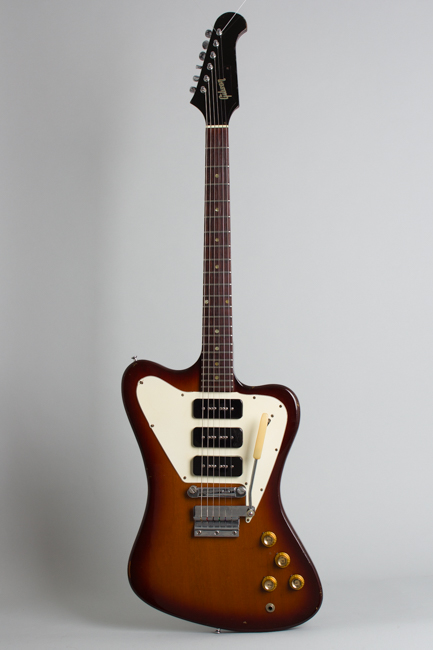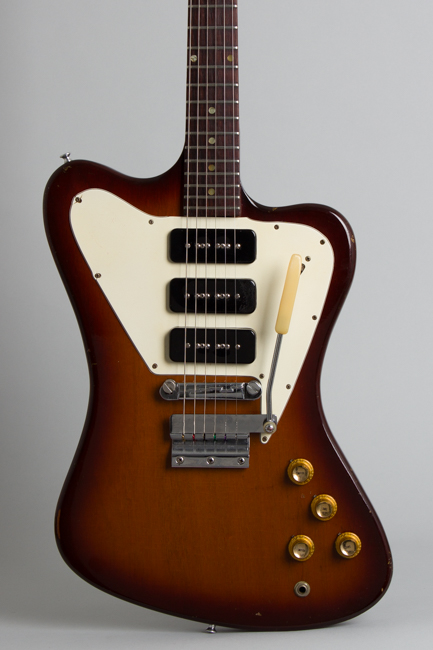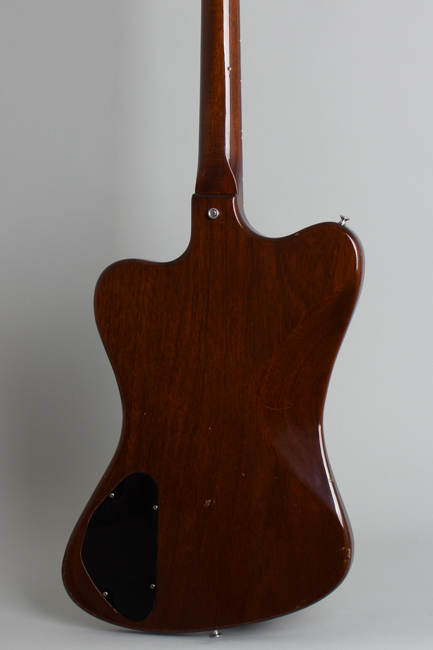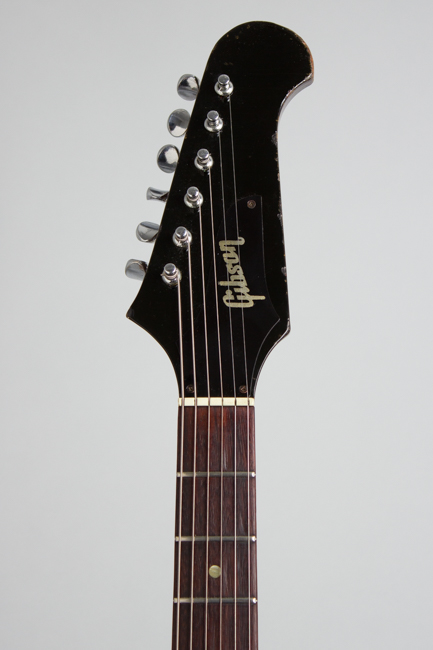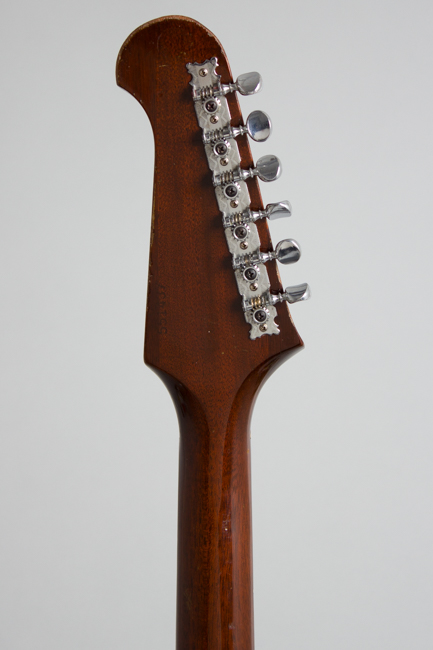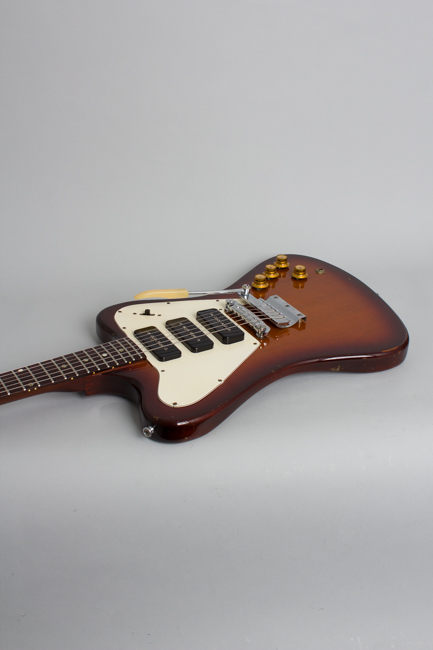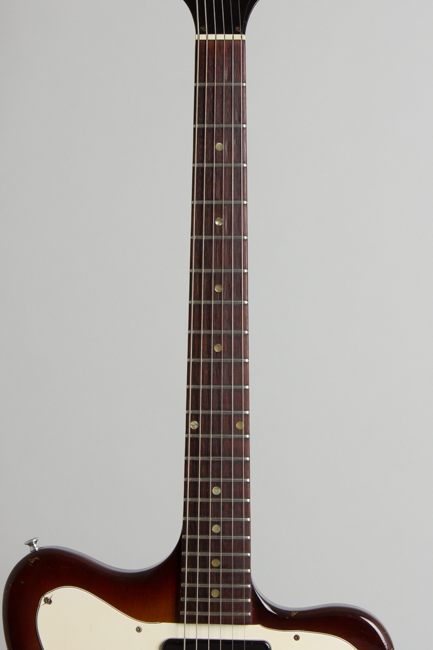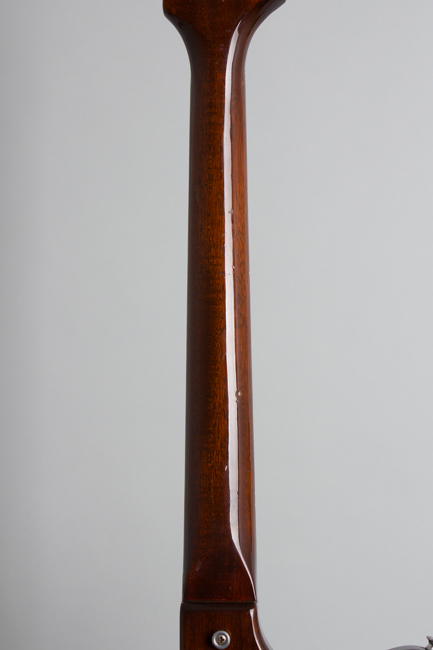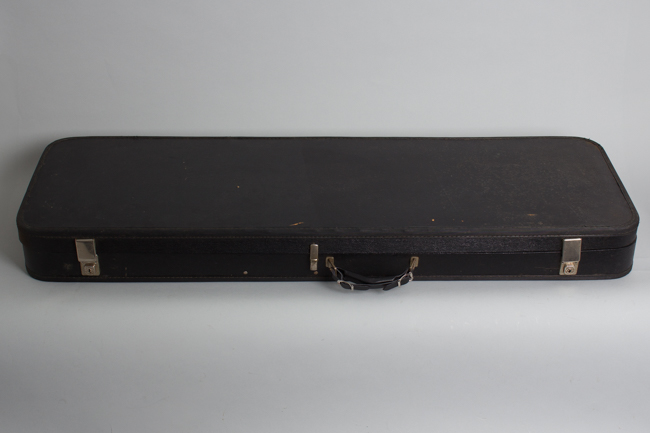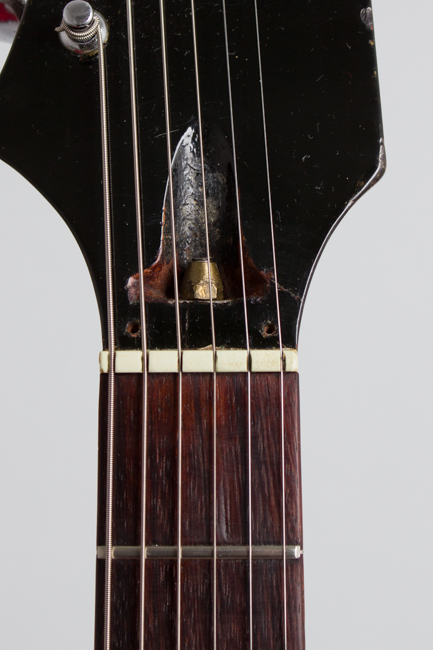Gibson Firebird III Solid Body Electric Guitar (1966)
Gibson Firebird III Model Solid Body Electric Guitar (1966), made in Kalamazoo, Michigan, serial # 551437, sunburst lacquer finish, mahogany body and neck, rosewood fingerboard, original black tolex hard shell case.
For a long time one of Gibson's less heralded 1960s classics, the second-try "non-reverse" Firebird models were lower-priced, simplified versions of the earlier "reverse" body Firebird series guitars. Introduced in at the summer NAMM show in 1965, the new Firebirds were available through the late 1960s in dwindling quantities, but never really caught on in a big way. This example midline-model Firebird III likely dates to the second production year 1966 and is finished in the standard sunburst, by far the most common livery. The list price in 1965-6 was $239.50 plus $31 for the new, cheaper # 310 case that had just been added to the line.
The body is fluidly sculpted Honduras mahogany with a one-piece glued-in neck, far simpler to build than the original multi-laminate neck-through-body Firebird design. The one-piece mahogany neck is topped by an unbound, dot inlaid rosewood fingerboard which unlike earlier versions it is the same for all models.
The non-reverse III is distinguished by offering not two but three plastic-covered P-90 pickups, an unusual combination that Gibson had not used before on a solidbody instrument. These are still mounted directly to the body, not to the pickguard as they later were. The wiring is the typical Gibson 3-pickup layout, with the bridge and neck selected individually and the center switch position being bridge and middle out of phase. With P-90's this gives a unique tone; sort of a "fat Strat" effect. These are selected by a fairly cheap slider switch that often broke; this one is intact.
Typically for 1966 this 'bird mounts chrome plated hardware, including Gibson's "short" Vibrola unit with a plastic-tipped handle and the stud-mounted solid bridge. The tubular arm on this one has the bend oriented in the opposite direction from most. The tuners are a Japanese-made openback strip, which Gibson started using on some models in early 1966 either due to budget considerations or possibly shortages from Kluson, the regular supplier. The knobs are the older capped early '60s style pieces, generally replaced by the "Witch Hat" style in later 1966-7. These are gold capped, which was usually reserved for gold-plated instruments but fittings in this period of peak Gibson production can be inconsistent at best and they appear original to the guitar.
The pots date to the 39th week of 1965; the serial number starting with 551 is a series not well documented for the 1960s but the specific features of the guitar suggest shipment in early-mid 1966. The nut width is the slimmer 1 9/16" that appeared in 1965 and is shared by all second generation Firebirds, narrower than earlier "reverse" Firebird necks but as it approaches the body the profile becomes noticeably chunkier than many period SG necks.
This is a great-sounding guitar, with powerful P-90 pickups that really growl when cranked in the single neck and bridge settings and bright and snarly out-of-phase middle. While the "non-reverse" Firebirds often used to be discounted in Gibson history, they have found a growing cadre of enthusiasts in the 21st century, enough for Gibson to finally re-issue the model recently. They remain distinctive guitars unlike any other in look or feel and excellent players instruments. Light, fast playing and super stylish, this Firebird III is a fine example of an oft-underappreciated Gibson model, an unrepentant rocker's guitar.
Overall length is 43 3/8 in. (110.2 cm.), 13 7/16 in. (34.1 cm.) wide at lower bout, and 1 3/8 in. (3.5 cm.) in depth, measured at side of rim. Scale length is 24 3/4 in. (629 mm.). Width of nut is 1 9/16 in. (40 mm.).
This is a clean and decently well-preserved 'bird for its 59 years on the planet, remaining nicely original overall showing some typical wear. There no major headstock or control cavity cracks as are common with these 'birds. Someone long ago opened up the sides of the truss rod cavity as bit, probably to enable use of an open-ended wrench on the nut. This caused a TINY split in the headstock veneer on the treble side of this, extending 1/2" into the grain of the mahogany just below the nut. This is sealed up and not an ongoing issue, but is visible as it has not been touched up.
The all-original finish shows light checking on the body but the fairly dark sunburst face shows hardly any fade. There are small dings, dents and chips scattered around with a couple of deep dinks to the top edge and one deep ding on the lower back. The headstock edges also have some typical small chips.
The pickups and wiring remain all original with pots coded 6539 dating to the second half of 1965. This guitar is built to the original pattern with the pickups screwed directly to the body; the lead pickup has been invisibly shimmed up for a stronger response. The original complex body routing in this area was ditched later in 1966 in favor of a large "swimming pool" rout, with the pickups hung from under the pickguard making them easier to adjust.
The pickguard shows shrinkage cracks off the two uppermost screws and some light pulls in several other places but is otherwise intact with no broken-off corners. The often-faded bird emblem has lost practically all the color fill and appears as a ghost image. Many of these pickguards have shrunken up far worse than this one has!
The original frets show light wear and still have plenty of meat to them, and most importantly the neck angle on this guitar is better than many of these, allowing the vibrato to function properly. Overall a GREAT playing and sounding Firebird, a nice find complete in its original #310 HSC lined with red fabric, not the "Picnic blanket "plaid sometimes used! Overall Excellent - Condition.
For a long time one of Gibson's less heralded 1960s classics, the second-try "non-reverse" Firebird models were lower-priced, simplified versions of the earlier "reverse" body Firebird series guitars. Introduced in at the summer NAMM show in 1965, the new Firebirds were available through the late 1960s in dwindling quantities, but never really caught on in a big way. This example midline-model Firebird III likely dates to the second production year 1966 and is finished in the standard sunburst, by far the most common livery. The list price in 1965-6 was $239.50 plus $31 for the new, cheaper # 310 case that had just been added to the line.
The body is fluidly sculpted Honduras mahogany with a one-piece glued-in neck, far simpler to build than the original multi-laminate neck-through-body Firebird design. The one-piece mahogany neck is topped by an unbound, dot inlaid rosewood fingerboard which unlike earlier versions it is the same for all models.
The non-reverse III is distinguished by offering not two but three plastic-covered P-90 pickups, an unusual combination that Gibson had not used before on a solidbody instrument. These are still mounted directly to the body, not to the pickguard as they later were. The wiring is the typical Gibson 3-pickup layout, with the bridge and neck selected individually and the center switch position being bridge and middle out of phase. With P-90's this gives a unique tone; sort of a "fat Strat" effect. These are selected by a fairly cheap slider switch that often broke; this one is intact.
Typically for 1966 this 'bird mounts chrome plated hardware, including Gibson's "short" Vibrola unit with a plastic-tipped handle and the stud-mounted solid bridge. The tubular arm on this one has the bend oriented in the opposite direction from most. The tuners are a Japanese-made openback strip, which Gibson started using on some models in early 1966 either due to budget considerations or possibly shortages from Kluson, the regular supplier. The knobs are the older capped early '60s style pieces, generally replaced by the "Witch Hat" style in later 1966-7. These are gold capped, which was usually reserved for gold-plated instruments but fittings in this period of peak Gibson production can be inconsistent at best and they appear original to the guitar.
The pots date to the 39th week of 1965; the serial number starting with 551 is a series not well documented for the 1960s but the specific features of the guitar suggest shipment in early-mid 1966. The nut width is the slimmer 1 9/16" that appeared in 1965 and is shared by all second generation Firebirds, narrower than earlier "reverse" Firebird necks but as it approaches the body the profile becomes noticeably chunkier than many period SG necks.
This is a great-sounding guitar, with powerful P-90 pickups that really growl when cranked in the single neck and bridge settings and bright and snarly out-of-phase middle. While the "non-reverse" Firebirds often used to be discounted in Gibson history, they have found a growing cadre of enthusiasts in the 21st century, enough for Gibson to finally re-issue the model recently. They remain distinctive guitars unlike any other in look or feel and excellent players instruments. Light, fast playing and super stylish, this Firebird III is a fine example of an oft-underappreciated Gibson model, an unrepentant rocker's guitar.
Overall length is 43 3/8 in. (110.2 cm.), 13 7/16 in. (34.1 cm.) wide at lower bout, and 1 3/8 in. (3.5 cm.) in depth, measured at side of rim. Scale length is 24 3/4 in. (629 mm.). Width of nut is 1 9/16 in. (40 mm.).
This is a clean and decently well-preserved 'bird for its 59 years on the planet, remaining nicely original overall showing some typical wear. There no major headstock or control cavity cracks as are common with these 'birds. Someone long ago opened up the sides of the truss rod cavity as bit, probably to enable use of an open-ended wrench on the nut. This caused a TINY split in the headstock veneer on the treble side of this, extending 1/2" into the grain of the mahogany just below the nut. This is sealed up and not an ongoing issue, but is visible as it has not been touched up.
The all-original finish shows light checking on the body but the fairly dark sunburst face shows hardly any fade. There are small dings, dents and chips scattered around with a couple of deep dinks to the top edge and one deep ding on the lower back. The headstock edges also have some typical small chips.
The pickups and wiring remain all original with pots coded 6539 dating to the second half of 1965. This guitar is built to the original pattern with the pickups screwed directly to the body; the lead pickup has been invisibly shimmed up for a stronger response. The original complex body routing in this area was ditched later in 1966 in favor of a large "swimming pool" rout, with the pickups hung from under the pickguard making them easier to adjust.
The pickguard shows shrinkage cracks off the two uppermost screws and some light pulls in several other places but is otherwise intact with no broken-off corners. The often-faded bird emblem has lost practically all the color fill and appears as a ghost image. Many of these pickguards have shrunken up far worse than this one has!
The original frets show light wear and still have plenty of meat to them, and most importantly the neck angle on this guitar is better than many of these, allowing the vibrato to function properly. Overall a GREAT playing and sounding Firebird, a nice find complete in its original #310 HSC lined with red fabric, not the "Picnic blanket "plaid sometimes used! Overall Excellent - Condition.
